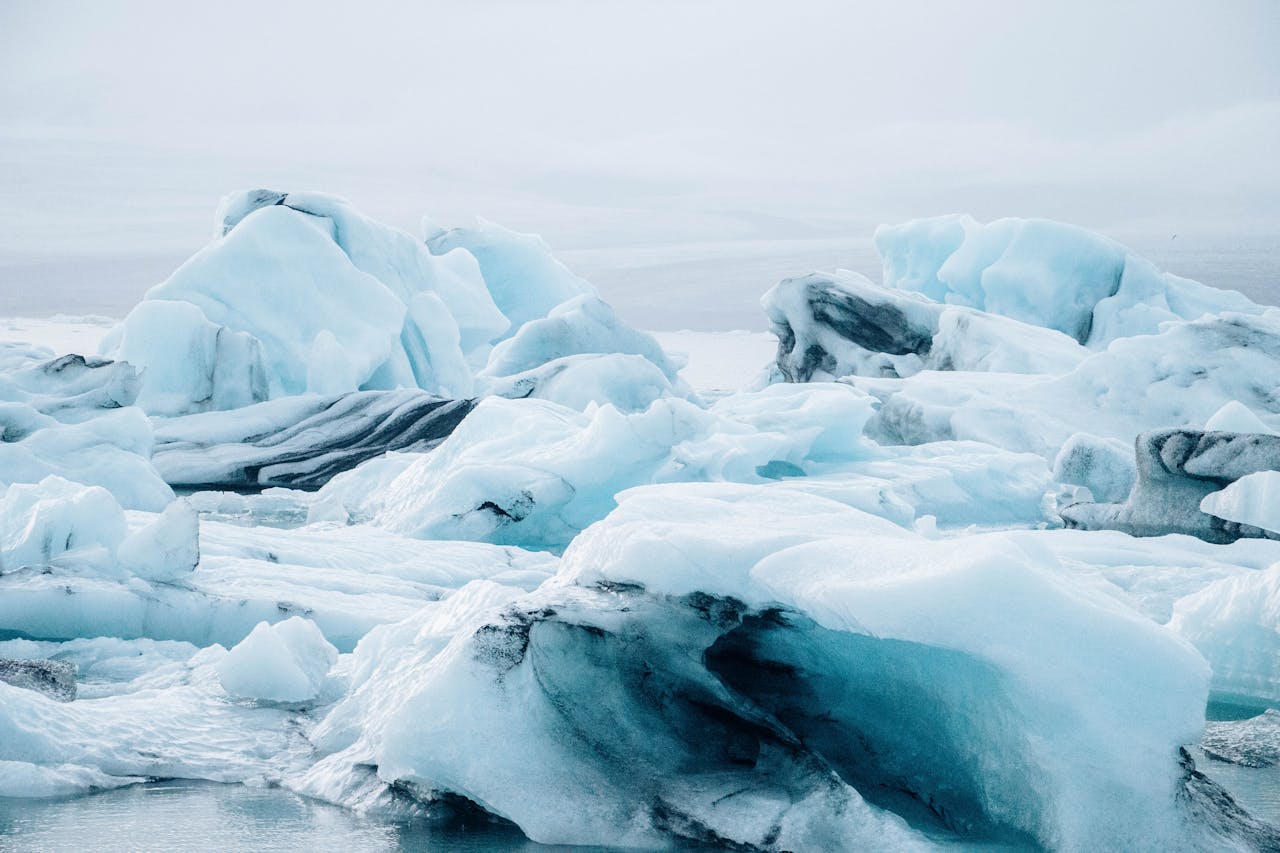If Earth’s climate were left to its own devices, we’d be on a slow, steady path toward another ice age — one that would bury much of the Northern Hemisphere under massive ice sheets in about 10,000 years. That prediction isn’t guesswork. It’s based on cycles that have repeated for nearly a million years, driven by nothing more than Earth’s slow tilt, wobble, and drift around the sun.
So why isn’t anyone preparing for it?
Because something unprecedented is happening: greenhouse gas emissions from human activity have disrupted that ancient rhythm. Earth’s orbit still points toward glaciation, but the atmosphere we’ve changed may now block it entirely.
The Natural Mechanics of Earth’s Ice Age Cycles
For the past million years, Earth’s climate has followed a remarkably regular pattern: alternating cold glacial periods and warmer interglacials. These swings aren’t random. They’re driven by predictable changes in Earth’s orbit and axial tilt—phenomena collectively known as Milankovitch cycles.
Milankovitch cycles include three main parameters:
- Obliquity: This is the tilt of Earth’s axis, which shifts between about 22.1 and 24.5 degrees every 41,000 years. Obliquity affects how much sunlight reaches the poles. More tilt means warmer polar summers, which tends to reduce ice cover.
- Precession: This is the wobble in Earth’s rotational axis, completing a full cycle roughly every 21,000 years. Precession alters the timing of seasons and how sunlight is distributed between hemispheres.
- Eccentricity: This refers to the shape of Earth’s orbit around the Sun, which changes from nearly circular to more elliptical in cycles of 100,000 and 400,000 years. Eccentricity modulates how much seasonal variation precession can produce.
By comparing geological data, like oxygen isotope ratios in ocean sediment cores, with calculations of these orbital variations, scientists have mapped out the timing of glaciations over hundreds of thousands of years. The result: a clear and reproducible pattern.
Researchers found that the start of glacial periods is closely linked to changes in obliquity, while the retreat of ice sheets tends to follow shifts in precession. Eccentricity plays more of a supporting role, modifying the strength of the other two factors.
In short, Earth‘s ice ages don’t arrive randomly. They follow a schedule dictated by astronomy. Without human interference, this schedule indicates that the next ice age should begin approximately 10,000 to 11,000 years from now.
Why We Should Be Headed Into Another Ice Age
If we removed the influence of human activity and let Earth’s natural climate system run on its own, we’d be slowly drifting toward the next ice age — one that should begin in about 10,000-11,000 years. It’s a projection based on strong, reproducible patterns in the geological and astronomical record.
Scientists have confirmed that every glacial period in the past million years began during specific alignments of Earth’s orbital parameters. This includes a certain range of axial tilt (obliquity) combined with precession and orbital shape (eccentricity) that collectively reduce solar energy reaching northern latitudes — the region most influential in triggering glaciation. When those three factors align just right, ice sheets begin to grow.

Researchers were able to match the expansion and retreat of past ice sheets to precise phases in these orbital cycles by analyzing deep-sea sediment cores. These sediments contain tiny shells from marine microorganisms that record changes in temperature and ice volume through the ratio of oxygen isotopes in their shells. These records go back hundreds of thousands of years and show consistent timing between orbital shifts and major climate transitions.
This means Earth’s climate, at least on these long timescales, follows a relatively predictable rhythm. Without any interference, we’d expect this interglacial period — the one we’ve been living in since the last ice age ended 11,700 years ago — to end in about another 10,000 years. After that, global temperatures would fall gradually, polar ice sheets would begin to expand again, and we’d slowly enter another glacial period expected to last tens of thousands of years.
But that’s only if we weren’t changing the game.
The Disruption: How Human Activity Is Delaying (or Canceling) the Next Ice Age
The Earth’s climate system was on track for another ice age — until we got involved.
Since the industrial revolution, human activity has been releasing greenhouse gases, particularly carbon dioxide, into the atmosphere at a rate far outside anything seen in the past 800,000 years. That increase is already having immediate effects: rising global temperatures, melting glaciers, and extreme weather. But what’s less widely understood is the long-term consequence — we’ve disrupted the timing of the next ice age.
The same research that uncovered how predictable ice age cycles have been also shows how far off course we’ve now gone. Multiple studies confirm that if atmospheric CO₂ stays elevated, the next glacial period won’t just be delayed. It may not happen at all. Some models suggest that current CO₂ levels could prevent glaciation for at least 100,000 to 500,000 years.
The mechanism is simple: greenhouse gases trap heat. That extra energy in the atmosphere cancels out the slow cooling effect that Earth’s changing orbit would otherwise bring. In essence, we’ve put a wedge into the gears of the natural climate cycle, interrupting a process that has repeated consistently for a million years.
This isn’t theoretical. It’s already measurable. According to climate researchers, the natural cues for ice sheet growth are already starting to line up — but the Earth isn’t cooling. Instead, it’s heating up. CO₂ is now rising ten times faster than at any point in the last 50,000 years. That’s a geologic anomaly, and it’s driven entirely by us.
This shift isn’t just about timing. It rewrites Earth’s climate trajectory over geological time. Delaying an ice age might sound like good news on the surface, but the implications are far from reassuring.
What This Means for Us and Why It’s Not ‘Good News’
At first glance, the idea of delaying an ice age might sound like a win. No mile-thick glaciers covering continents, no collapsing ecosystems due to extreme cold. But that interpretation misses the point entirely. We’ve not just paused an ice age — we’ve thrown the climate system into unfamiliar territory.
Historically, Earth’s glacial cycles were part of a balanced rhythm, characterized by long periods of cooling followed by natural warming. Civilizations like ours developed during a stable warm stretch known as the Holocene, which began after the last ice age ended around 11,700 years ago. That period of stability is what allowed agriculture, cities, and eventually the modern world to flourish.
Now, that stability is unraveling.

Rising CO₂ levels are pushing the planet into a long-term warming phase for which there is no precedent in human history. Global temperatures are rising, polar ice is melting, and sea levels are climbing — not slowly over millennia, but rapidly over decades. Some estimates suggest that if current emissions continue, Antarctica could be nearly ice-free in just 8,000 years, contributing to a sea-level rise of up to 70 meters. That’s not a theoretical problem for future generations — it’s a global restructuring of coastlines and ecosystems.
And while a future ice age would have brought real challenges, today’s warming is already delivering them: extreme heat, floods, droughts, wildfires, and disruptions to agriculture and water supplies. These are not distant risks. They’re here now.
What we’re seeing isn’t a delay of danger — it’s a substitution. We’ve avoided one form of natural disruption by creating another, arguably more unpredictable and harder to reverse. That trade-off is not in our favor.
What Science Can and Can’t Predict
The research around Earth’s natural climate rhythms tells us something powerful: our planet’s long-term behavior is not chaotic. For nearly a million years, glacial and interglacial cycles have followed a pattern shaped by orbital physics. That predictability gave scientists confidence to forecast that, under natural conditions, we’d enter our next ice age in about 10,000 years.
But that baseline no longer holds.
What happens next depends less on celestial mechanics and more on human decisions. Greenhouse gases have altered the climate system in ways that may last hundreds of thousands of years. That kind of shift isn’t just a scientific footnote — it redefines the timeline for life on Earth.
Still, there are limits to what science can forecast. We can model future orbital alignments with precision, but the future of human behavior, and how effectively we curb emissions, remains uncertain. What researchers can do now is map out two diverging paths: the one Earth would naturally follow, and the one we’re currently forcing it onto.
Understanding those two paths doesn’t just inform policy. It reframes how we think about climate, not as a short-term problem to fix by 2100, but as a system we’re reshaping for the next 10,000 to 100,000 years. That long view is sobering, but it also makes something clear: the climate legacy we leave behind is a choice, not a given.
My Personal RX on Navigating Cold Weather and Immune Support
There is a predictable pattern every winter: energy dips, immune systems get sluggish, and chronic conditions flare up. Cold weather doesn’t just affect your mood—it influences everything from your circulation to your digestion to your ability to fight off viruses. But winter doesn’t have to be a season of survival. With a few intentional habits, you can actually thrive in colder climates, supporting your immunity, mood, and metabolism from the inside out. The key is to stay warm, stay nourished, and give your gut and immune system the care they need to power through the season strong.
- Fortify Your Gut to Strengthen Immunity: Your immune system relies heavily on gut health, especially during the colder months. MindBiotic delivers probiotics, prebiotics, and adaptogenic Ashwagandha to help balance immunity, reduce stress, and support gut-lung defense.
- Eat Warming, Immune-Smart Meals: The Mindful Meals cookbook features 100+ comforting, nutrient-rich recipes designed to support immunity and reduce inflammation. Think hearty stews, turmeric teas, and antioxidant-packed winter vegetables.
- Prioritize Vitamin D and Sunlight: Limited sun exposure in winter can affect immune strength and mood. Supplement wisely, and try to get natural sunlight when possible; even brief midday walks help.
- Keep Moving to Keep Circulation Strong: Cold temperatures slow circulation, making you feel sluggish. Daily movement, even indoor stretching or brisk walking, keeps your body warm and your immune cells active.
- Layer Up and Protect Extremities: Cold stress suppresses immunity. Dress in layers, protect your hands and feet, and keep your core temperature stable to help your body maintain resilience.
- Hydrate (Even If You’re Not Thirsty): People often forget to drink water in cold weather. Proper hydration keeps mucous membranes moist, your body’s first line of defense against airborne viruses.
- Sleep Deeply and Consistently: Longer nights are nature’s cue to rest. Use this time to improve sleep hygiene, as quality sleep directly enhances immune system activity and recovery.
- Reduce Refined Sugar to Reduce Risk: Sugar suppresses white blood cell function for hours after consumption. Trade cold-weather treats for warm, naturally sweet foods like baked apples or cinnamon-roasted squash.
- Use Herbs and Spices to Build Defense: Ginger, garlic, cinnamon, and oregano are winter superstars that not only warm the body but also boost circulation and immunity.
- Manage Stress to Prevent Burnout Illness: Emotional stress is a hidden immune suppressor. Build in time for rest, connection, and calming rituals—your immune system works better when you’re mentally balanced.
Sources:
- Barker, S., Lisiecki, L. E., Knorr, G., Nuber, S., & Tzedakis, P. C. (2025). Distinct roles for precession, obliquity, and eccentricity in Pleistocene 100-kyr glacial cycles. Science, 387(6737). https://doi.org/10.1126/science.adp3491
- Scientists match Earth’s ice age cycles with orbital shifts. (2025, February 27). The Current. https://news.ucsb.edu/2025/021777/scientists-match-earths-ice-age-cycles-orbital-shifts
- Cermak, A. (2024, October 22). Milankovitch (Orbital) Cycles and Their Role in Earth’s Climate – NASA Science. NASA Science. https://science.nasa.gov/science-research/earth-science/milankovitch-orbital-cycles-and-their-role-in-earths-climate/
- Cooper, K. (2025, March 11). The next ice age is coming in 10,000 years — unless climate change prevents it. Space. https://www.space.com/the-universe/earth/the-next-ice-age-is-coming-in-10-000-years-unless-climate-change-prevents-it
Featured image: Pexels











 Subscribe to Ask Dr. Nandi YouTube Channel
Subscribe to Ask Dr. Nandi YouTube Channel










